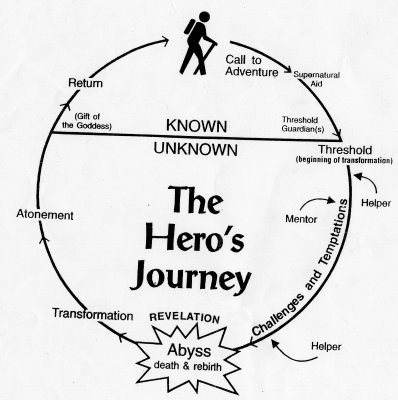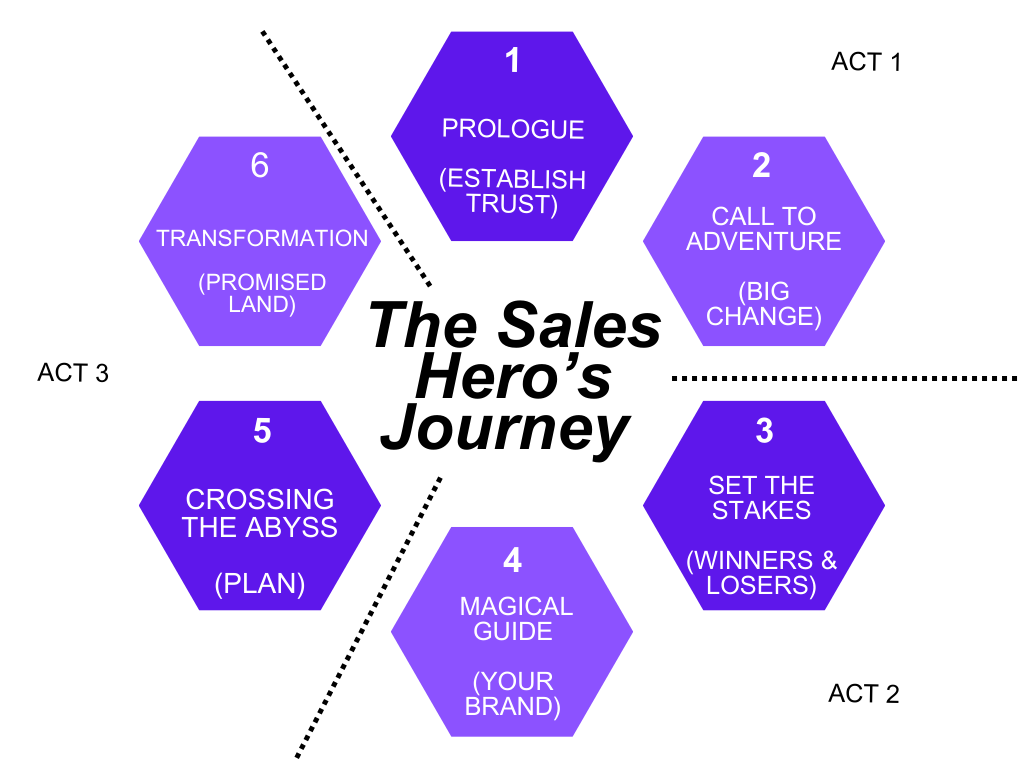The Greatest Sales Storytelling Framework I've Ever Used
Most sales decks are a barrage of bullshit. It doesn't have to be that way.
After 12 years in marketing, I've developed a sick kink I’m a little bit embarrassed to admit: I love crafting sales stories and decks.
It's a fucking strange, I know, but hear me out: Your sales story is the most critical piece of content you’ll create. And YET — most of them are painfully awful. A barrage of bullshit, told by an idiot, full of features and jargon, signifying nothing.
It's the alcoholic bad-boy boyfriend of content assets. How could you NOT want to fix it? Over the years, I’ve developed a six-step narrative structure to revamp sales narratives and decks. It’s called the Sales Hero’s Journey. (Suggestions for better names are welcome! I haven’t trademarked this fucker yet.)
The Sales Hero’s Journey
This framework draws heavily from several sources of inspiration: Donald Miller’s Storybrand, this Andy Raskin post, and — obviously — Joseph Campbell’s Hero’s Journey.
The Sales Hero’s Journey
This framework draws heavily from several sources of inspiration: Donald Miller’s Storybrand, this Andy Raskin post, and — obviously — Joseph Campbell’s Hero’s Journey.
Campbell taught for 60 years at my alma mater, Sarah Lawrence College. He was so popular that they named the Sports Center after him, although I don’t think he was a big gym guy. I once split my head open while playing ultimate frisbee on mushrooms there, so suffice it to say that Campbell and I have a pretty special connection.
The Sales Hero’s Journey from Sales differs from the Hero’s Journey in that it has 6 steps instead of 17 and a modified order. (After much trial and error, I realized that a sales meeting differs significantly from a Star Wars script and that Goldman Sachs does not appreciate it when you bring a lightsaber to a pitch.)
And of course, it’s designed to turn you into an absolute sales hero.
I’m presenting this framework for the specific use case of making a sales or pitch deck, but you can also use it to craft your core brand narrative and messaging. Let’s get into it.
1) Prologue: Establish trust
Great stories are about transformation, and they follow a similar pattern. A character goes on an adventure with high stakes, meets a magical guide, and together, they overcome obstacles until they reach the Promised Land, transformed. In this framework, the main character is your customer, and the magical guide is your brand.
Before launching into this classic narrative structure, though, we need an introduction that establishes trust — in literary terms, a prologue. Why? Most buyers are skeptical. They’ve been burned before, so you need to establish yourself as someone they can relate to and trust — fast. You only have a couple of minutes before they tune out and start checking Slack and Instagram.
My favorite way to do this is with a 90-second Founding Story that communicates who you are and what you care about. (Check out a deeper guide on the ideal structure of this story here.)
For the sake of this post, I’m going to share how I used this framework at Contently — a journalist-founded content marketing platform that I spent eight years building, which connected a network of the world's top journalists and creatives with brands who wanted to tell great stories. It got pretty big for a time, and this kind of story was a huge reason why.
At Contently, I’d start every meeting with a potential new client with something like this:
Before we get started, I just want to tell you a little bit about us. Contently was founded to help brands tell great stories, and how we got started was serendipitous. One of our founders, Joe, was a serial entrepreneur who needed content for his blog and social channels to connect with his audience, but he struggled to find great writers who could write more than garbage SEO content. So he called his childhood best friend, Shane, who was at Columbia journalism school and had a huge network of top-tier freelance journalists looking for more work.
They realized that a lot of companies needed this kind of help, so they brought in our third founder, Dave, the technologist, to build a platform that would connect the world’s best storytellers with brands who wanted to build deeper relationships with their audience. Over the years, we’ve helped hundreds of brands do just that — from Marriott to Chase to American Express.
This story was compelling because it established trust and relatability with our target buyers, most of whom were either a) ex-journalism majors who went into marketing or b) entrepreneurs who immediately resonated with the problem that inspired us to start Contently.
In this story, you need to answer three crucial questions: Why did you start your company? Whose problem were you trying to solve? What’s the good intention behind your work?
I can’t stress this enough: Time yourself. Make sure that it’s under 90 seconds or else you’ll risk losing your audience.
2) The Call to Adventure: Identify a force of change in the world
Next, it’s time to frame the prospect as the protagonist. And like all the great protagonists — Luke Skywalker, Odysseus, Ashton Kutcher in Dude Where’s My Car? — they must set out on an adventure.
What’s spurring them on that adventure? A force of change that’s pushing them to act. For instance, at Contently, we argued that the behavior of buyers had fundamentally changed. They researched products in depth before ever talking to sales. They avoided intrusive advertising with pop-up blockers. As a result, we were entering a new age of marketing — one where you needed to deliver high-quality content every step of the way.
This slide always got a lot of head nods, and it put people in the mindset of “Damn, I need a lot of good content.” Which, of course, is what Contently helped them create.
3) Set the stakes
Next, it’s time to set the stakes and show that there will be winners and losers from this big force of change in the world. You’re trying to inspire your target buyer to act, so the stakes need to feel personal — like the difference between succeeding and failing in their job.
At Contently, we showed this with a simple stat: 5% of all branded content earned 90% of the attention. A few brands were winning the content wars; the rest were flailing.
A single, memorable stat like this is gold. If you work at an enterprise AI company, maybe it’s that only 14% of companies have seen any sort of ROI from AI, but those that do are gaining a key competitive advantage.
If you’re in fintech, maybe it’s that 72% of Gen Z does online-only banking and won’t sign up for a bank without a killer app.
You should also show what winning looks like — providing 1-2 compelling examples (of existing customers, of course.)
4) Introduce the Magical Guide
You’ve set up a momentous challenge and high stakes for your audience. It’s time to introduce your brand as the magical guide that can help them reach the promised land.
How do you that? With a straightforward statement that tells them who you are and the value you deliver.
Resist the temptation to infuse this statement with a lot of jargon or unnecessary detail. Make it so simple that your prospect could easily repeat it to a co-worker.
5) Crossing the Abyss (a step-by-step plan)
It’s time to give your prospect a plan of exactly how you’ll help them overcome their obstacles and cross the abyss. Our brains love a plan: it satisfies the Type-A freak inside all of us, engaging our prefrontal cortex and procedural memory.
At Contently, I’d lay out a three-step plan that presented our product as a “magic gifts” (h/t Raskin) that would help them overcome their challenges, combining world-class content strategy, technology, and talent.
And I’d put them in a Venn diagram because the only thing people love more than a plan is a Venn Diagram. Just look at those three overlapping circles. It’s beautiful.
6) Transformation: Show the Promised Land (With Customer Examples)
Every great story is about transformation. So, the final part of your sales story should show what a successful transformation looks like, with ROI stats to back it up. This is your opportunity to tell the stories of your best customers.
I also love to include customer testimonials at this stage. People trust recommendations from friends and peers more than any other sort of marketing, and seeing their peers rave about your company is incredibly powerful. Testimonials are criminally underutilized.
One big thing to remember: A sales story isn’t a broadcast; it’s a conversation. Just like when you’re telling a story to a friend at happy hour, there should be questions, interjections, and — if you really nailed it — enthusiastic gestures of agreement along the way.
Over the years, this framework has served me well. Everyone at your company needs to be singing the same song, and this framework is easy for your entire sales team to pick up — commonly resulting in a 15%+ bump in close rate.
If you work in marketing, don’t look at your sales story as someone else’s problem. It’s the most important brand story you’ll tell. Your job isn’t to write case studies or bullshit the MQL numbers in Hubspot. It’s to drive revenue and grow the business. This is your story to tell.
I write this newsletter for free, so if you liked this post, share it with someone who would find it useful.
If you liked this post, you might also like:
I’m the best-selling author of The Storytelling Edge and a content nerd. Subscribe to this newsletter to get storytelling and audience-building strategies in your inbox each week.












Totally resonate with "Our brains love a plan: it satisfies the Type-A freak inside all of us".
My clients love when I present a (simple) plan!
Love this! Wish everyone who sold to me used this strategy!